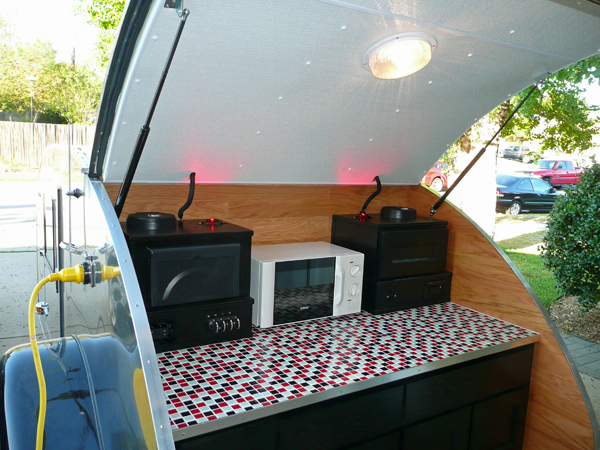lfrazer98 wrote:I am still trying to figure out how to get the wires that I need that may be running under the trailer to the galley hatch area.... That is where my current brake and marker light wires are, but I want to put brake lights on the galley hatch. I am thinking I will have to go up the side wall (sandwich style) before the outer skin is on then to the galley hatch by the hinge. However, is there something special I need to do where the hole is that the wire will enter the side wall through? A flanged hole that can be caulked? I should have run the wires in the floor before I was sealed up, but I didn't think that far ahead. My dilemma is about where the wires enter the wall. There has got to be something to buy that allows the wires entrance, but keeps out water. I know Tom posted something about running wires through conduit under his trailer, but I am not sure if he shared how the wires entered the trailer.
Hi Lauren,
I did use two runs conduit for wiring from the front of the teardrop to the galley. One conduit was for 12v DC trailer fixtures. The other conduit was for primarily for 120v AC wiring. The main trailer lighting wiring is not within conduit. I used a sheathed 4-wire cable and ran it exposed on the bottom side of my teardrop from the trailer connector at the front back to the galley area. It is held in place by a combination of zip ties around the frame rail and cable clamps screwed into the bottom of my floor.
All of my wiring entered the galley area through the floor in the lower left galley cabinet. I drilled slightly over size holes for the two conduits and the one trailer wire and filled the voids with sealant. The picture below shows where the wiring entered the galley area next to the galley bulkhead.

The terminal strips in the picture are for the trailer lighting. Each wire of the four wire trailer wire goes to a separate strip. The individual trailer lights are wired to the strips. The terminal strips are necessary but for me it made things easier. (You may notice some wiring from the terminal strips feeding into the conduit. These go back up toward the front of the teardrop to the front side marker lights.) While I did have some 12v and 120v wiring inside my walls and in the roof framing, none of my trailer lighting was run inside. For the side marker lights, I just drilled through the sidewalls. I used some sealant around the side marker lights to seal them.
For my hatch mounted trailer lighting, I did not run the wiring through the sidewalls. On the hatch, I ran wiring from the lights through the outer skin and then through the hatch framing. The wiring exits the hatch framing near the hatch spar where the hurricane hinge is mounted.

The wiring ended in a four-pin trailer wire connector. (Note: there are two 4-pin connectors is because I had "extra" wiring in the hatch for speakers and light.) The reason I used connectors was for the possibility of having to remove the hatch (which I never have done.)
The wiring for the rear side marker lights and the galley-mounted rear tailights was surface mounted to the galley bulkhead. The tailight wiring was run up from the terminal strips through the galley counter and into my upper galley cabinet. It's a little hard to see from my messy temporary wiring below, but you can see the general path of the wiring in the lower galley cabinet. (This particular cabinet is for battery storage, battery disconnect, wiring chase, and 12v distribution panel.)

The tailight wiring (and speaker and light wiring) were run exposed along the back of the upper cabinets and end in a matching 4-pin connectors so they can connect to the hatch wiring. I used split loom cable wrap around the exposed wiring to make it look more attractive then just the wiring alone.

I didn't intend to hijack your build thread. Hopefully this information is beneficial.
Take care,
Tom




